Suunto EON Steel Black User Guide 3.0
Decompression algorithms
Suunto's decompression model development originates from the 1980s when Suunto implemented Bühlmann's model based on M-values in Suunto SME. Since then research and development has been ongoing with the help of both external and internal experts.
In the late 1990s, Suunto implemented Dr. Bruce Wienke's RGBM (Reduced Gradient Bubble Model) to work with the earlier M-value based model. The first commercial products with the feature were the iconic Suunto Vyper and Suunto Stinger. With these products the improvement of diver safety was significant as they addressed a number of diving circumstances outside the range of dissolved-gas-only models by:
- Monitoring continuous multiday diving
- Computing closely spaced repetitive diving
- Reacting to a dive deeper than the previous dive
- Adapting to rapid ascents which produce high microbubble (silent-bubble) build-up
- Incorporating consistency with real physical laws for gas kinetics
Suunto EON Steel Black has two decompression algorithms available: Suunto Fused™ RGBM 2 algorithm and Bühlmann 16 GF algorithm. Choose the appropriate algorithm for your dive under Dive settings » Parameters » Algorithm.
All decompression models are theoretical and have their benefits and limitations. When you choose the appropriate decompression algorithm and personal setting or gradient factors for your dive, always take your personal factors, the planned dive, and your dive training into consideration.
Although it is possible, changing the algorithm between dives is not recommended when no-fly time calculation is active.
Make sure your Suunto dive computer always has the latest software with updates and improvements. Check before every dive trip from www.suunto.com/support, if Suunto has released a new software update for your device. When a new software update is available, you must install it before diving. Updates are made available to improve your user experience and are part of Suunto's philosophy of continuous product development and improvement.
Suunto Fused™ RGBM 2 algorithm
The Suunto Fused™ RGBM 2 combines and improves widely respected Suunto RGBM and Suunto Fused™ RGBM decompression models developed by Suunto together with Dr. Bruce Wienke. (Suunto dive algorithms are a culmination of expertise and knowledge accumulated over decades of development, testing and thousands upon thousands of dives.)
In Suunto Fused™ RGBM 2 the tissue half-times are derived from Wienke’s Full RGBM where human body is modeled by fifteen different tissue groups. Full RGBM can utilize these additional tissues and model the on-gassing and off-gassing more accurately. The amounts of nitrogen and helium on-gassing and off-gassing in the tissues are calculated independently from each other.
Suunto Fused™ RGBM 2 algorithm supports open-circuit and closed-circuit diving up to a depth of 150 meters. Compared to previous algorithms, Suunto Fused™ RGBM 2 is less conservative on deep air dives, allowing shorter ascent times during decompression dives. In addition, the algorithm no longer requires tissues to be completely free of residual gases when calculating no-fly times, thereby reducing the required time between your last dive and flying.
The advantage of Suunto Fused™ RGBM 2 is additional safety through its ability to adapt to a wide variety of situations. For recreational divers it may offer slightly longer no- deco times, depending on the chosen personal setting. For open-circuit technical divers it allows use of gas mixes with helium - on deeper and longer dives helium based gas mixes provide shorter ascent times. And finally, for rebreather divers the Suunto Fused™ RGBM 2 algorithm gives the perfect tool to be used as a non-monitoring, set point dive computer.
Suunto EON Steel devices with software version earlier than 2.0 use Suunto Fused™ RGBM algorithm. Once updated to the latest software, Suunto Fused™ RGBM 2 will be installed to the dive computer.
Bühlmann 16 GF algorithm
The Bühlmann decompression algorithm was developed by Swiss physician Dr. Albert A. Bühlmann, who researched into decompression theory starting from 1959. The Bühlmann decompression algorithm is a theoretical mathematical model describing the way in which inert gases enter and leave the human body as the ambient pressure changes. Several versions of the Bühlmann algorithm have been developed over the years and adopted by many dive computer manufacturers. Suunto’s Bühlmann 16 GF dive algorithm is based on the model ZHL-16C. This model has 16 different theoretical tissue groups with half times from 4 minutes up to 635 minutes.
Gradient factors
Gradient Factor (GF) is a parameter which is used only with the Bühlmann dive algorithm. GFs are a way to add conservatism to the Bühlmann algorithm by adding deepstops to the dive. GFs are divided into two separate parameters, Gradient Factor Low and Gradient Factor High. By using GF with the Bühlmann algorithm you can set your safety margin for the dive by adding conservatism to control when different tissue compartments reach their acceptable M‑value.
Gradient factors are always defined as percentages. The Low % value determines the first deepstop, while the High % value defines the allowed M-value once surfacing. Using this method, the GF changes throughout the ascent.
A commonly used combination is GF Low 30% and GF High 70%. (Also written as GF 30/70.) This setting means that the first stop would take place once the leading tissue reaches 30% of its M-value. The lower the first number is, the less supersaturation is allowed. As a result, the first stop is required when you are deeper. In the following illustration, GF Low is set to 30% and the leading tissue compartments react to the 30% limit of M-value. At this depth the first decompression stop takes place.
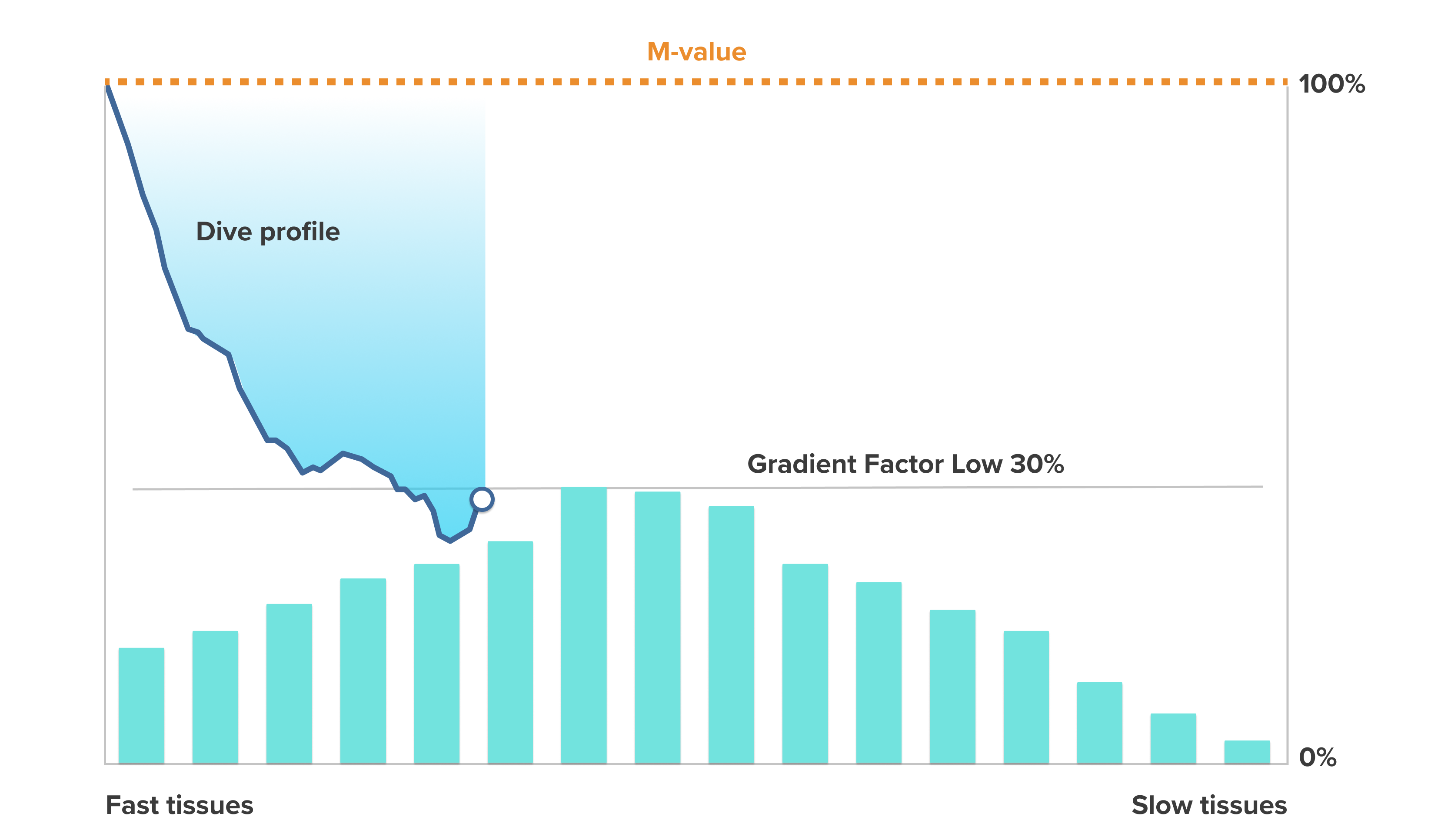
When the ascent continues, the GF moves from 30% to 70%. GF 70 indicates the amount of supersaturation allowed when you get to the surface. The lower the GF High value is, the longer shallow stop is needed in order to off-gas before surfacing. In the following illustration, GF High is set to 70% and the leading tissue compartments react to the 70% limit of M-value. At this point you can come back to the surface and finish your dive.
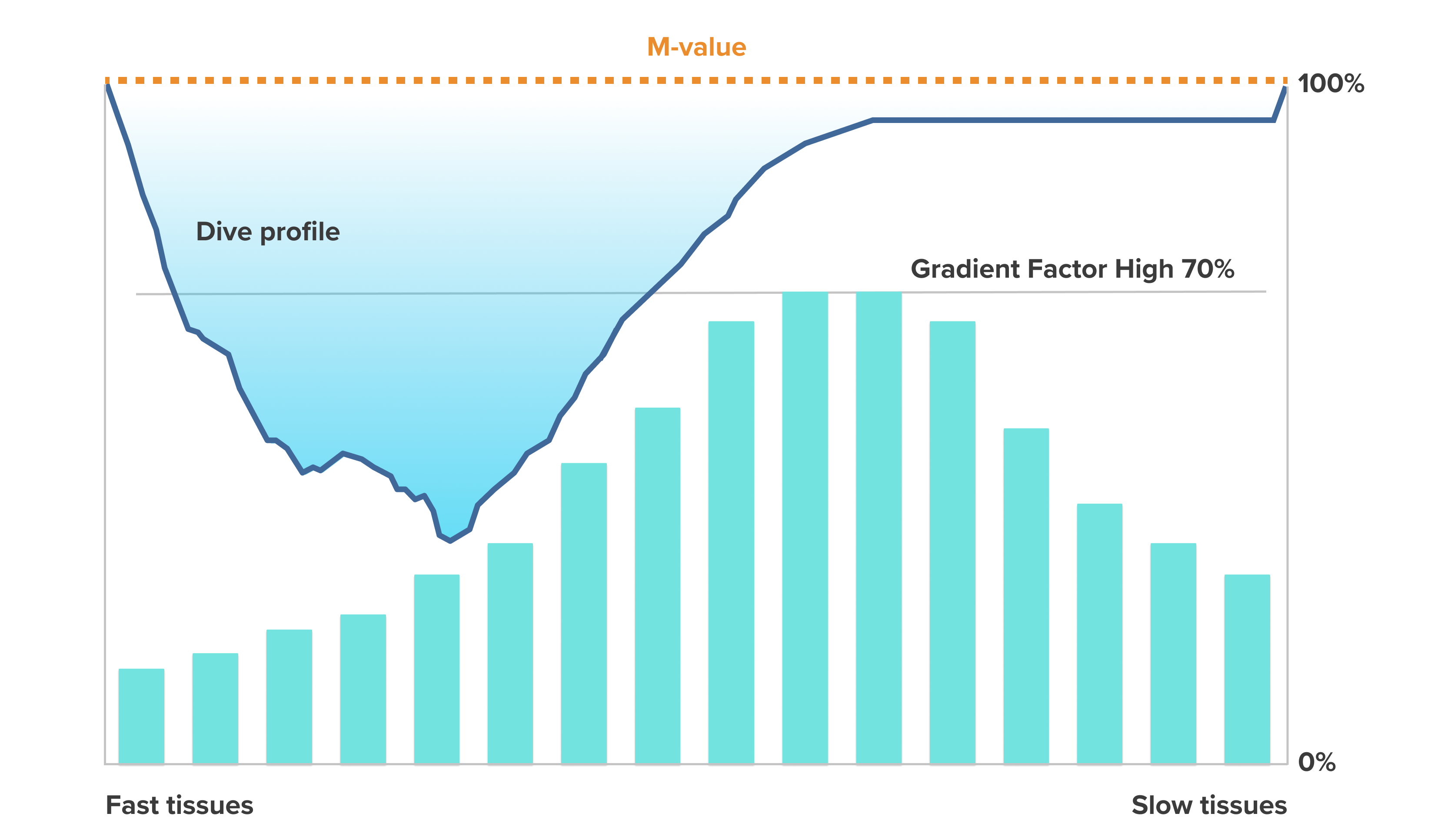
The default setting of Suunto's Bühlmann 16 GF dive algorithm is 30/70. All values other than the default values are out of recommendation. If you modify the default values, the value number turns red and a warning appears on the screen.
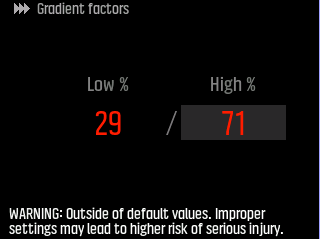
Do not edit gradient factor values until you understand the effects. Some gradient factor settings can cause a high risk of DCS or other personal injury.
The effects of gradient factors on the dive profile
GF Low % effect on dive profile is illustrated in the following picture. It shows how GF Low % determines the depth where the ascent starts slowing down and the depth of the first decompression stop. The illustration shows how the different GF Low % values change the depth of the first stop. The higher the GF Low % value is, the shallower the first stop occurs.
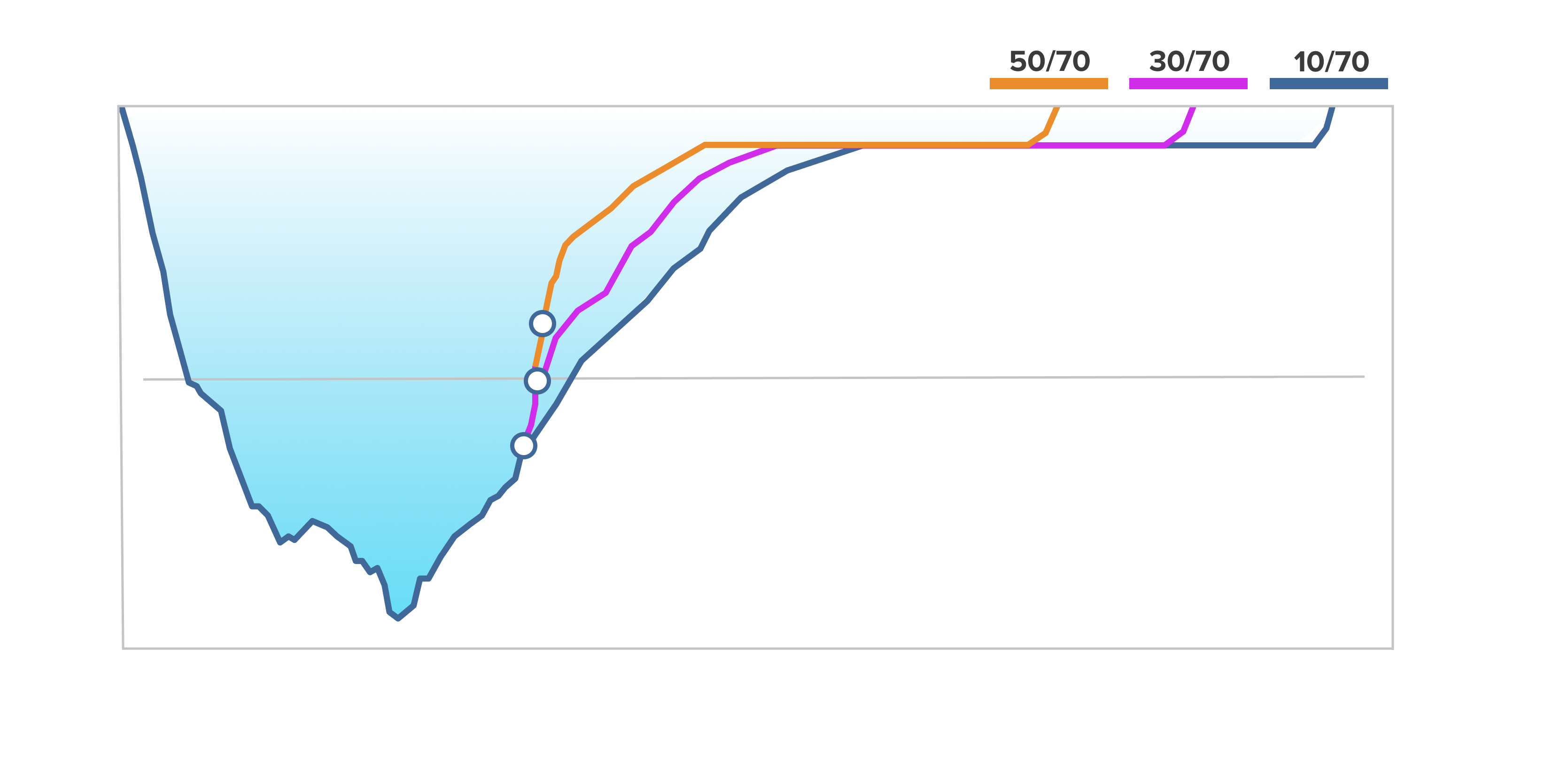
If GF Low % value is too low, some tissues may still on-gas when the first stop occurs.
GF High % effect on the dive profile is illustrated in the following picture. It shows how GF High % determines the decompression time spent in the shallow phase of the dive. The higher the GF High % value is, the shorter the total dive time is, and the less time diver spend in shallow water. If GF High % is set to a lower value, the diver spends more time in shallow water and total dive time gets longer.
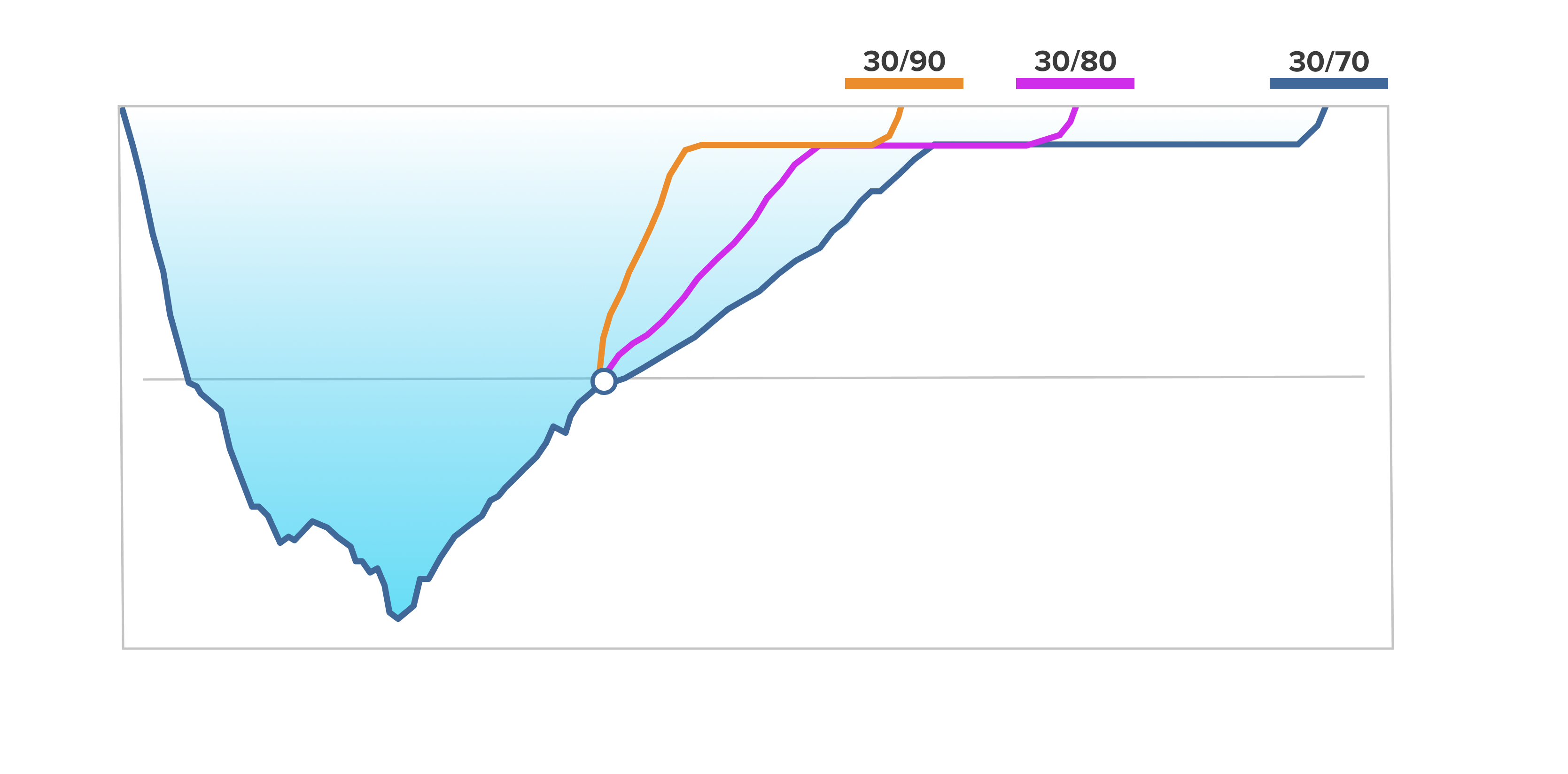
If you want to see the comparison of the Suunto Fused™ RGBM 2 algorithm and the Bühlmann 16 GF algorithm, go to suunto.com/support.
Diver safety
Because any decompression model is purely theoretical and does not monitor the actual body of a diver, no decompression model can guarantee the absence of DCS.
Always use the same personal and altitude adjustment settings for the actual dive and for the planning. Increasing the personal adjustment setting from the planned setting as well as increasing the altitude adjustment setting can lead to longer decompression times deeper and thus to larger required gas volume. You can run out of breathing gas underwater if the personal adjustment setting has been changed after dive planning.
Oxygen exposure
The oxygen exposure calculations are based on currently accepted exposure time limit tables and principles. In addition to this, the dive computer uses several methods to conservatively estimate the oxygen exposure. For example:
- The displayed oxygen exposure calculations are raised to the next higher percentage value.
- The CNS% limits up to 1.6 bar (23.2 psi) are based on 1991 NOAA Diving Manual limits.
- The OTU monitoring is based on the long-term daily tolerance level and the recovery rate is reduced.
Oxygen related information displayed by the dive computer is also designed to ensure that all warnings and displays occur at the appropriate phases of a dive. For example, the following information is provided before and during a dive when the computer is set to Air/Nitrox or Trimix (if helium is activated in use):
- The selected O2% (and possible helium %)
- CNS% and OTU (visible only after your customization in Suunto app)
- Audible notification when CNS% reaches 80%, then warning when 100% limit is exceeded
- Notification when OTU reaches 250 and then warning when 300 limit is exceeded
- Audible alarm when pO2 value exceeds the preset limit (pO2 high alarm)
- Audible alarm when pO2 value is < 0.18 (pO2 low alarm)
WHEN THE OXYGEN LIMIT FRACTION INDICATES THAT THE MAXIMUM LIMIT IS REACHED, YOU MUST IMMEDIATELY TAKE ACTION TO REDUCE OXYGEN EXPOSURE. Failure to take action to reduce oxygen exposure after a CNS%/OTU warning is given can rapidly increase the risk of oxygen toxicity, injury, or death.